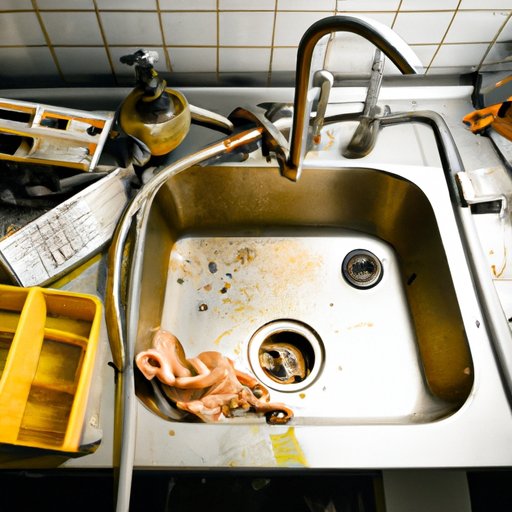I. Introduction
Garbage disposals are an essential part of every household’s kitchen. They provide convenience and hygiene by shredding food waste and disposing of it. However, like all machines, garbage disposals can malfunction and break down. This comprehensive guide aims to equip you with the knowledge and skills necessary to fix your garbage disposal. In this article, we will cover a step-by-step guide, common issues, safety precautions, preventative measures, and a video tutorial.
II. Step-by-Step Guide
Before you start, it’s important to gather the necessary tools. You will need a flashlight, pliers, a screwdriver, an Allen wrench, and a bucket. Here’s a step-by-step guide to fixing your garbage disposal:
Step 1: Turn off the power supply – Locate the power cord plug and disconnect it from the outlet. Alternatively, you can switch off the circuit breaker that powers the garbage disposal.
Step 2: Inspect the disposal – Use a flashlight to inspect the disposal and identify the problem. Check if there are any foreign objects stuck inside, such as bones or utensils. Look for any signs of damage, leaks, or cracks.
Step 3: Clear the disposal – Use pliers to remove any visible debris or foreign objects from the disposal. Avoid using your hands, and never put your fingers inside the disposal.
Step 4: Attempt a reset – There is a reset button located at the bottom of the garbage disposal. Press it to reset the disposal. Wait for a few minutes before attempting to use it again. If the disposal still doesn’t work, proceed to step 5.
Step 5: Use the Allen wrench – Underneath the disposal, you’ll find a hole in the center. Insert an Allen wrench to turn the rotor back and forth. This will loosen any jammed debris that is causing the disposal to malfunction.
Step 6: Reset and Test – After the jam is cleared, press the reset button again and turn on the power supply. Test the disposal by running water and turning it on. If the disposal runs smoothly, you have successfully repaired it.
Tips: Avoid clogging the disposal by only inserting small food scraps at a time. Run cold water before and after use to flush away debris.
III. Troubleshooting Common Problems
Here are some common issues you may encounter while using your garbage disposal and how to fix them:
1. Clogged Drain – If your kitchen sink drains slowly or not at all, this may be due to a clogged drain line. Use a plunger or drain snake to clear the drain line. Avoid using chemical drain cleaners that may damage your garbage disposal.
2. Leaks – A leaking garbage disposal can be caused by loose mounting bolts, damaged gaskets, or cracks in the disposal. Tighten the mounting bolts, replace the gaskets, or replace the disposal if it is cracked.
3. Humming Noise – If your garbage disposal only makes a humming noise when you turn it on, this may be due to a jammed rotor. Follow the steps outlined in section II to remove the debris causing the jam.
4. Won’t Turn On – If the garbage disposal doesn’t turn on at all when you flip the switch, check that it is plugged in or that the circuit breaker hasn’t tripped. If these are not the issue, the motor may be damaged, and you should contact a professional.
IV. Video Tutorial
For a visual guide to fixing your garbage disposal, watch this video tutorial. It will demonstrate the process step-by-step and provide a visual guide to the tools used.
V. Safety Precautions
Before attempting any repair on your garbage disposal, it’s essential to take the necessary precautions to avoid injury. Here are some safety tips:
1. Turn off the power supply – Always turn off the power supply to the garbage disposal before attempting any repair.
2. Never use your hands – Never put your fingers inside the garbage disposal, as it can cause severe injury.
3. Use the correct tools – Always use the right tools for the job, such as pliers, a screwdriver, and an Allen wrench. Avoid using makeshift tools or your hands.
VI. Preventative Measures
To avoid future problems with your garbage disposal, follow these preventative measures:
1. Properly dispose of food waste – Only insert small food scraps at a time and avoid putting in fibrous or starchy foods like potato skins or celery. These can cause clogging.
2. Regular maintenance – Clean the disposal regularly by pouring a mixture of baking soda and vinegar down the drain and flushing it with hot water. This will help prevent clogs and eliminate odor.
VII. Conclusion
Fixing your garbage disposal can be a simple process if you follow the steps outlined in this comprehensive guide. Remember to take the necessary safety precautions and maintain your disposal regularly. With these tips, you can keep your garbage disposal running smoothly and avoid costly repairs.
